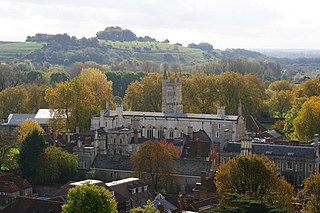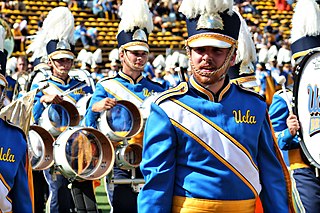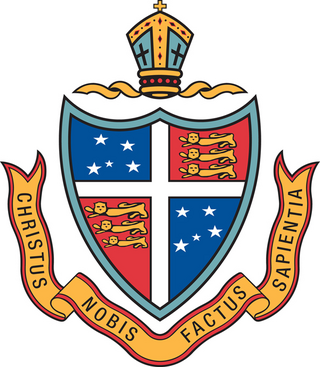
Oxbridge is a portmanteau of the Universities of Oxford and Cambridge, the two oldest, wealthiest, and most famous universities in the United Kingdom. The term is used to refer to them collectively, in contrast to other British universities, and more broadly to describe characteristics reminiscent of them, often with implications of superior social or intellectual status or elitism.

Winchester College is an English public school with some provision for day attendees, in Winchester, Hampshire, England. It was founded by William of Wykeham in 1382 as a feeder school for New College, Oxford, and has existed in its present location ever since. It is the oldest of the nine schools considered by the Clarendon Commission. The school has begun a transition to become co-educational, and has accepted male and female day pupils from September 2022, having previously been a boys' boarding school for over 600 years.

Eton College is a 13–18 public fee-charging and boarding secondary school for boys in Eton, Berkshire, England. It is noted for having educated prime ministers, world leaders, Nobel laureates, Academy Award and BAFTA award-winning actors, and generations of the aristocracy, having been referred to as "the nurse of England's statesmen". The school is the largest boarding school in England ahead of Millfield and Oundle. Eton charges up to £52,749 per year. Eton was noted as being the sixth most expensive HMC boarding school in the UK in 2013–14.

Deakin University is a public university in Victoria, Australia. Founded in 1974, the university was named after Alfred Deakin, the second Prime Minister of Australia.

School colors, also known as university colors or college colors, are the colors chosen by a school, academy, college, university or institute as part of its brand identity, used on building signage, web pages, branded apparel, and the uniforms of sports teams. They can promote connection to the school, known as "school spirit", and help differentiate it from other institutions.
Maroon is a brownish crimson color that takes its name from the French word marron, or chestnut. "Marron" is also one of the French translations for "brown".

Geelong Grammar School is a private Anglican co-educational boarding and day school. The school's main campus is located in Corio on the northern outskirts of Geelong, Victoria, Australia, overlooking Corio Bay and Limeburners Bay.
Royal blue is a deep and vivid shade of blue. It is said to have been created by a consortium of mills in Rode, Somerset, which won a competition to make a robe for Queen Charlotte, consort of King George III. In winning the prize, a business in the village invented the dye and received a certificate to sell it under that name.

The oldest football clubs trace their origins to the mid-19th century, a period when football evolved from being a casual pastime to an organised mainstream sport.

The Geelong College is an Australian independent and co-educational, Christian day and boarding school located in Newtown, an inner-western suburb of Geelong, Victoria.
The University Match in a cricketing context is generally understood to refer to the annual fixture between Oxford University Cricket Club and Cambridge University Cricket Club.
During the early modern era, pupils, former pupils and teachers at English public schools developed the rules of football, eventually leading to the first written codes of football most notably the Eton College (1815) and Aldenham school (1825) football rules, and rugby football (1845). British public schools football also directly influenced the rules of association football.

Cambridge Blue is the colour commonly used by sports teams from the University of Cambridge. There is contextual and historical variation. The colour used since the mid-20th century by Cambridge University Boat Club is greener than that used by Cambridge University R.U.F.C.. This rowing colour was created when Alf Twinn, the boatman from 1934 to 1984, added more yellow to this shade, reportedly to distinguish it from the rugby club's colour.
Cricket, and hence English amateur cricket, probably began in England during the medieval period but the earliest known reference concerns the game being played c.1550 by children on a plot of land at the Royal Grammar School, Guildford, Surrey. It is generally believed that cricket was originally a children's game as it is not until the beginning of the 17th century that reports can be found of adult participation.

Edward Lyttelton was an English schoolmaster, cleric and sportsman from the Lyttelton family who was headmaster of Eton College from 1905 to 1916. During his early years he played first-class cricket for Cambridge University and Middlesex.
The Eton v Harrow cricket match is an annual match between public school rivals Eton College and Harrow School. It is one of the longest-running annual sporting fixtures in the world and is the last annual school cricket match still to be played at Lord's. In February 2022, the MCC announced that from 2023 onwards the fixture would no longer be held at the ground. It would be replaced by the finals of boys’ and girls’ schools competitions, as stated by MCC to be more inclusive. However, in September, 2022, following opposition from a section of its membership, the club decided that the match would be held at Lord's in 2023 to allow time for further consultation. In March, 2023 it was announced that the fixture would continue to be played at Lord's until at least 2027, following which there would be a review and a possible vote in 2028 on whether the match should remain at Lord's.

In the Commonwealth, a public school is a type of fee-charging private school originally for older boys. They are "public" in the sense of being open to pupils irrespective of locality, denomination or paternal trade or profession; nor are they run for the profit of a private owner.

Oxford Blue is the official colour of the University of Oxford. The official Oxford branding guidelines set its definition as Pantone 282, equivalent to the hex code #002147.
The London Academy of Excellence, Stratford (LAE) is a selective free school sixth form college located in the Stratford area of the London Borough of Newham, England. It has approximately 480 pupils and 32 teachers.
William Henry Bonsey was an English first-class cricketer active in 1839 who played for Marylebone Cricket Club (MCC). He was born in Upton-cum-Chalvey and died in Eastbourne. He appeared in two first-class matches.











